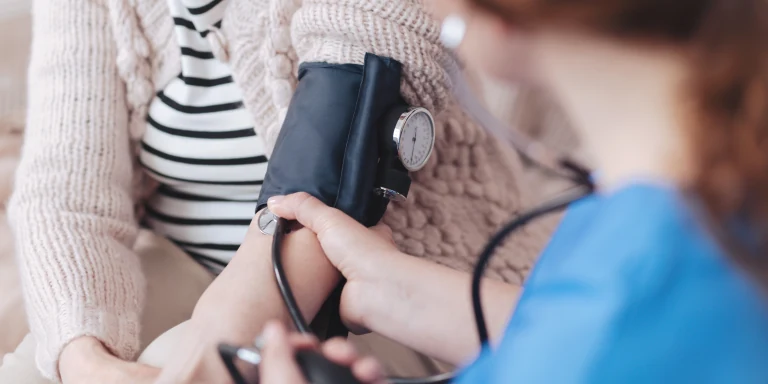
What can you do about high blood pressure?
High blood pressure, also known as hypertension, is widespread and entails a number of consequences that can impact quality of life. Therefore, it is important to inform yourself, know the possible causes, and take steps to counteract these.
What is high blood pressure?
High blood pressure is when the pressure at which the blood presses against the walls of your blood vessels is too high for a long period of time. But what does this mean exactly, and how do you differentiate high blood pressure from normal or low blood pressure? To help us understand this, let’s take a closer look at the terms “systolic” and “diastolic”.
Systolic blood pressure (the upper reading) describes the pressure at the moment when the heart muscle contracts, pumping oxygen-rich blood into the vessels. Diastolic blood pressure (the lower reading), on the other hand, shows the pressure on the blood vessels when your heart muscles relax. High blood pressure (hypertension) occurs when the systolic value is at 140 mmHg (millimetres of mercury) or higher and/or when the diastolic value is 90 mmHg or higher in readings across different days.
There are two types of hypertension: primary and secondary. Primary hypertension does not have a clear cause and develops gradually over a number of years. Secondary hypertension is caused by illness or medication.
Whether you have high blood pressure or not: getting enough exercise in your everyday life is important for your own well-being. The best thing you can do is to integrate small bits of exercise into your daily routine, whether it’s walking for short distances or riding your bike to your destination.
Achieve your personal health goals with the Helsana Coach app
Need support? The Helsana Coach app gives you helpful tips and shows you exercises you can incorporate into your day-to-day life. Helsana Coach also provides fascinating background information and answers to key health-related questions.
High blood pressure and possible symptoms
High blood pressure can be accompanied by symptoms that are not always obvious. There are even people who don’t have any symptoms at all. For this reason, many people only discover they have high blood pressure during a routine blood pressure reading.
Possible symptoms of high blood pressure are:
- Headaches
- Dizziness and nausea
- Disturbed sleep
- Inner restlessness and nervousness
- Heart palpitations
- Shortness of breath when exerting effort
The sooner hypertension is identified, the better. After all, the longer it goes undetected, the higher the risk of cardiovascular disease. So, it is important to measure your blood pressure regularly – even if you feel well.
Good to know: when you measure your blood pressure, the following readings indicate that you might have high blood pressure:
- Diastolic (lower) reading: 90 mmHg or higher
- Systolic (upper) reading: 140 mmHg or higher
Generally speaking, blood pressure is a little higher in the morning than in the evening. For best results, make sure to always measure your blood pressure at the same time each day.
High blood pressure: what can cause it?
High blood pressure can be caused by a number of different things. Make sure you’re aware of this so that you can take preventive measures and lower your risk of hypertension.
Your personal lifestyle plays a key role when it comes to high blood pressure. An unbalanced diet with too much salt, fat and sugar, plus too little exercise, being overweight, and consuming alcohol and tobacco can all cause hypertension. Genetics can also play a factor – a predisposition to high blood pressure can be inherited, so if your parents or siblings have high blood pressure, then your chances of having it may be increased too. Chronic stress and mental strains can also contribute towards high blood pressure. Under these circumstances, being able to manage stress well is key: this will help you keep calm, which will help lower your blood pressure.
By the way, men are more likely to be affected by hypertension from a younger age. For women, the risk increases from the menopause.
What can you do to combat high blood pressure?
The key to treating high blood pressure is timely diagnosis. This will enable you to treat it quickly and lower the risk of potential consequences, such as cardiovascular illnesses. The main way of diagnosing hypertension is by having repeated blood pressure measurements carried out at your GP’s surgery, by having patients carry out measurements at home, or by conducting a 24-hour blood pressure measurement. The causes and extent of the condition can also be clarified through blood tests, urine analyses and imaging procedures, such as ultrasound examinations of the kidneys and the heart.
Regardless of whether your doctor identifies hypertension at an earlier or later stage, it must be treated. This can be done in a number of different ways, depending on the severity and impacts of the high blood pressure. Alongside treatment through medication, there are also different measures that you can take to treat high blood pressure naturally. When asking yourself “What can you do to combat high blood pressure?”, it is worth considering these methods. Lifestyle plays a central role here.
Lowering your blood pressure: home remedies and diet
Home remedies help to lower high blood pressure. Although they are no replacement for visiting the doctor, certain foods make a meaningful contribution. A low-salt diet with lots of fresh fruit and vegetables can be hugely beneficial in keeping your blood pressure in balance. Too much salt can increase blood pressure, while fruit and vegetables contain vital nutrients and antioxidants that you need for healthy blood pressure. You should also avoid alcohol, nicotine and caffeine as much as possible.
You can also try ginger. It is known to slightly widen your blood vessels, which will in turn help you to lower your blood pressure. Beetroot is also rich in nitrates, which can also help lower blood pressure.
Lower blood pressure through medication
Depending on the severity of your hypertension and the associated risk factors, immediate treatment through medication may be necessary – alongside a change in your lifestyle habits. Long-term treatment through medication will be necessary if your blood pressure has not lowered after three to six months despite changing your lifestyle.
Lower your blood pressure in three minutes: exercise and stress reduction
Getting enough exercise – especially endurance sports, such as running, swimming and cycling – can lower blood pressure and strengthen your cardiovascular system. But it’s not just endurance sports that are effective against hypertension: isometric exercises can also regulate your blood pressure. These exercises only take up a few minutes a day and are easily integrated into your daily routine.
Plank
- Start in a push-up position.
- Support your body using your forearms.
- Keep your body in a straight line from your head to your toes.
- Hold this position for 2–3 minutes, if possible.
Wall sit
- Stand with your back against a wall.
- With your back against the wall, slide down until your knees are at a 90-degree angle.
- Hold this position for 2–3 minutes, if possible.
Stress is another factor that can cause high blood pressure. Relaxation methods such as certain breathing techniques can lower blood pressure.
4-7-8 breathing technique
- Breathe in through your nose for 4 counts.
- Hold your breath for 7 counts.
- Breathe out through your mouth for 8 counts.
- Repeat this exercise 3 times.
Important: Make sure to consult your doctor about these kinds of measures. This will give you a comprehensive overview of all options available to you, and you can find out which natural remedies will complement the medication you’re taking to treat your high blood pressure. Regular check-ups are key to monitoring the success of treatment and adapting it where necessary.
High blood pressure – the consequences of hypertension
If your blood pressure is too high in the long term and this is undetected for a long period of time, then hypertension can have unpleasant consequences. Hypertension damages your large and small blood vessels, which heightens the risk of heart attack, circulatory disorders and other cardiovascular illnesses. Circulatory disorders don’t just affect the heart but can also impact other organs, such as the kidneys or the eyes in the form of glaucoma . The brain can also be affected, which can cause cognitive issues to occur.
Making conscious lifestyle choices, going for regular check-ups and having individual treatment can help you keep your blood pressure in check and lead an active life. Keeping an eye on your blood pressure and taking preventive steps are worthwhile.

Sabrina Stollberg is a specialist in general surgery recognised by the Swiss Medical Association (FMH) and a research associate in Helsana’s Public Health Sciences team. She provided the editorial team with advice and input for this article.


Newsletter
Find out more about current health issues every month and get all the information you need about our attractive offers from all Helsana Group companies * delivered by e-mail to read whenever it suits you. Our newsletter is free of charge and you can sign up here:
We did not receive your information. Please try again later.
* The Helsana Group comprises Helsana Insurance Company Ltd, Helsana Supplementary Insurances Ltd and Helsana Accidents Ltd.
